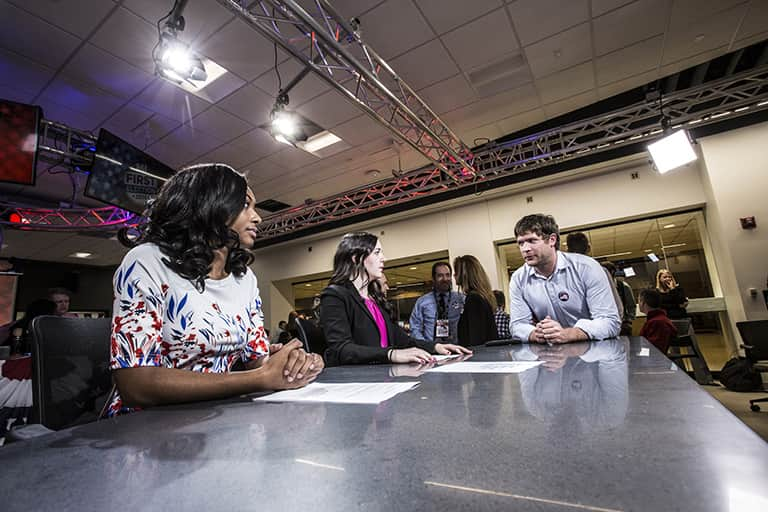Immersive experiences within new spaces at the MSU College of Communication Arts and Sciences are empowering students with the acumen they'll need to excel in competitive, tech-driven media careers.
The college's new Spartan Newsroom and Immersive Media Studio invite students to collaborate, gain real-life experiences and build professional skills. The newsroom welcomed its first students in fall 2016 and went "live" during the General Election, while the immersive studio opened for classes in January 2017. The innovative, cross-functional spaces equip students for 21st century jobs by engaging them in the development and delivery of news, animation, game design and immersive interactive media content involving motion capture, augmented and virtual realities.
"Having the experience to work within a professional pipeline facility will make a student's transition into a real-world situation smoother and more successful," says Stacey Fox, professor of animation, mixed realities and immersive journalism in the MSU School of Journalism. "It also teaches students the importance of respecting a production space."The expansive leaning spaces sit in the middle of the first floor of the ComArtSci building. Students and faculty are free to move seamlessly from one area to the next when producing or creating content, or when working on collaborative media projects. Many high-activity areas and broadcasting studios are viewable through glass walls, giving passers-by a Today Show experience.
Fox says students often remark on how lucky they feel to have such a beautiful, state-of-the-art facility in which to produce new works. She adds that the new space and studio places ComArtSci on the forefront alongside major universities like Arizona State University, California Institute of the Arts and New York University in offering curriculum and training in global media production.
"Our space is unique in that it has the latest in motion capture and learning technologies for classroom collaboration, production and immersion," says Fox. "Spartans and the general public are able to see the whole process in real time when they walk by and look through the floor to ceiling glass windows."
Learning by doing, learning with others
Julie Dunmire was in the initial group of students to experience the power of the new spaces. The broadcast journalism student worked in the newsroom on Election Day 2016, and was the first person to read a live report from the news anchor desk. Dunmire currently takes a class in the newsroom and sometimes interacts with students from other ComArtSci disciplines who are learning and working within the immersive spaces.
"News is not in 'silos' anymore," says Dunmire. "We have to stop thinking about ourselves as 'photojournalists' or 'writers' or 'anchors' because we will all have similar tasks and roles in a digital age."
Like Dunmire, other students believe that what you learn in a traditional classroom is far different than what you can learn in an immersive or real-world environment.
Media and Information undergraduate Michael Grassi focuses on 3D animation studies and is applying his craft through the immersive studio. His big take-away, he says, is learning to operate advanced motion capture systems and apply motion capture files to 3D animation.
"The new systems we have access to are professional grade equipment, and the products professionals use to make a living," says Grassi. "Knowing how to operate them and having access to their benefits as a college student preparing for the professional workplace gives us invaluable experience. It shortens the learning curve potential employers would face if they were to hire us."
Creative Advertising undergraduate Michael Cagney echoes the sentiment. Cagney is continuing to learn the ins and outs of the studio's motion capture system, and has begun to integrate motion capture skills into his other animation abilities. Those experiences, he says, have strengthened his confidence, and are shaping the direction he will take when he graduates in May.
"I've learned how to operate the motion capture system for myself and for others in a professional setting," he says. "I would like to pursue a job in animation and possibly mocap."
In addition to applying their skills in news, animation and motion capture arenas, students and faculty can design and produce virtual reality broadcasts and 360 animation renderings for immersive storytelling. The center opens up possibilities for cross-campus collaborations in almost any area, including those underway in athletics, health and medicine and theatre.
"Along with offering our courses in the space, we will also be utilizing the immersive media studio to host events such as game design jams, animation festivals and this February the Cultural Digi Summit in partnership with the Smithsonian Latino Center. We will have industry leaders in technology and culture in residence for two days utilizing the new spaces," says Fox. "It's a very exciting time to be at the MSU School of Journalism and ComArtSci."
